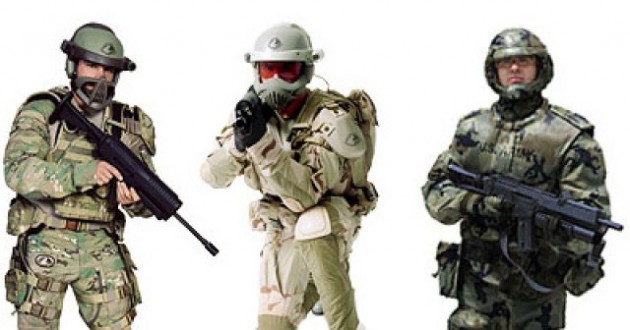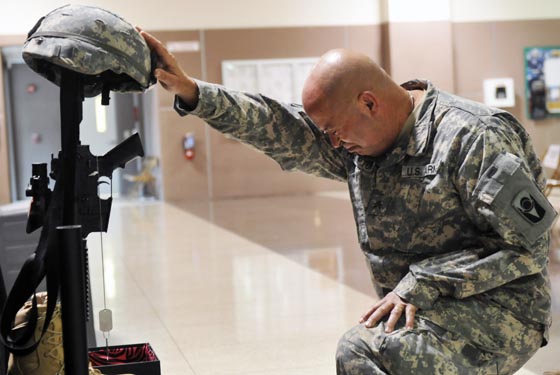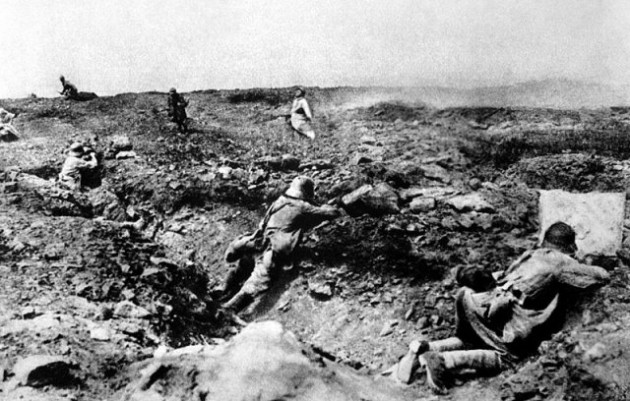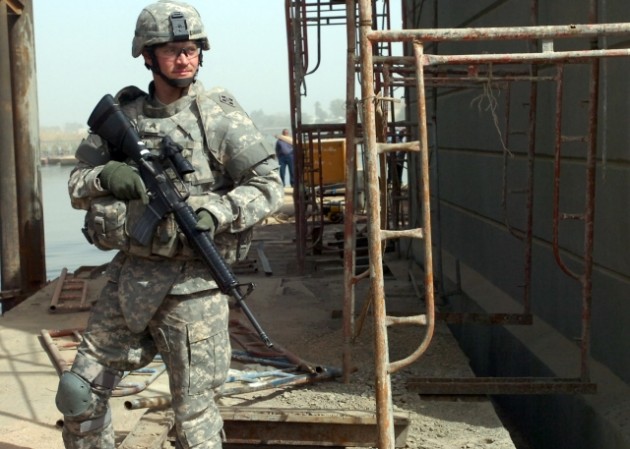SOCOM Wants YOU To Help Build High-Tech ‘Iron Man’ Armor
Posted on
US special operators are notoriously low-profile “silent professionals.” But lately the Internet’s been abuzz over Special Operations Command’s effort to build a high-tech suit of bulletproof armor – TALOS, the Tactical Assault Light Operator Suit – that the normally understated chief of SOCOM, Adm. William McRaven, actually compared to the metal-clad superhero Iron Man.
Make no mistake: This is no mistake. SOCOM is deliberately drumming up the hype because TALOS is the one thing they’re doing that they actually want everyone to hear about. It’s a conscious effort to get the word out to innovators in industry, academe, and even high schools who might otherwise have never thought of working with SOCOM. Why? Because without their help, TALOS is doomed to fail.
TALOS’s goals stretch the art of the possible to the breaking point. By contrast, the regular Army is moving steadily forward with incremental improvements to existing body armor – which is already way ahead of the protection troops had ten years ago – and intends to field a “Soldier Protection System” at least 10 percent lighter than current suits by 2016. But SOCOM wants to leap ahead to a bulletproof suit so heavy that a human could hardly move in it without a strength-enhancing mechanism called an exoskeleton – and it wants a functioning “proof of concept” prototype by 2018.
“The media frenzy that you’re talking about, that’s by design,” said Michael Fieldson, the SOCOM civilian who’s in charge of TALOS. “We want to get out there because this is a very challenging problem,” he told me. “You might not get there if you stuck to the traditional approach.”
TALOS has already gotten a lot of attention: 80 companies, 11 universities, and four government-funded laboratories participated in an August planning session addressed by Adm. McRaven. Of the 46 companies that showed specific products at a demonstration in July – also attended by McRaven, who stayed twice the time allotted on his official schedule – half a dozen are already building exoskeletons. But those systems right now are “rudimentary,” Fieldson admitted. The 2018 deadline is still going to be tight, he said: “We’ll need every minute of that five-year period.”
While SOCOM’s exploring all sorts of wearable computers, sensors, and advanced armor materials for its new super-suit, the highest and most crucial hurdle is the exoskeleton to carry all that weight – and the power system to run the exoskeleton. Current battery technology won’t cut it. Without some radical improvements, the exoskeleton will need a multi-kilowatt generator of the kind that runs on gas and weighs 50 to 100 pounds. “The guy’s basically going to carry around a Honda generator on his back,” Fieldson said. “How are we going to be able to generate that kind of power?”
TALOS doesn’t even have its own budget yet, Fieldson told me: “We’re not a program. We’re not a project. Right now, we’re a vision.”

Army concepts for future armor.
The Regular Army: Slow And Steady
Compare SOCOM’s high-risk, high-reward approach to the much more modest – and much more manageable – Soldier Protection System, which is now officially a “program of record.” (That said, no one would tell me the actual budget numbers). “We’re looking at beginning initial production in the third quarter of FY [fiscal year] ’15,” said Lt. Col. Frank Lozano, the Army’s Project Manager for Soldier Protective Equipment.
The Army has already awarded six development contracts, with more in negotiation. Ceradyne, Gentex, and Revision will develop competing helmets. Ceradyne and defense giant BAE will compete to build the body armor. AlphaMicron is (so far unchallenged) developing the eye protection, which will not only stop shrapnel but switch from sunglasses to clear at the touch of a button as troops move in and out of darkened buildings.
So who’s working on the exoskeleton for SPS? Well, nobody: It’s not going to have one.
“Different organizations look at different technologies based on their level of maturity,” Lozano told me. “I’m responsible for fielding capabilities that can be realized in three to 10 years….lighter-weight soft armor designs, lighter-weight ceramic designs, and lighter-weight helmet designs that I can get a five, 10, 15 percent weight reduction on immediately.”
In fact, Lozano expects most of the weight savings in SPS to come from more efficient design, not from new materials. “It’s probably 70:30,” he told me. Why? “Over the last ten years, we have needed to get new equipment out in the field very urgently,” he said. “That saves lives [but] you were constantly adding more material.” Now, with Iraq over, Afghanistan winding down, and the procurement system returning to a more deliberate approach, the Army actually has time to redesign its armor from scratch to get the most protection – and the least discomfort – for the lowest possible weight.
- An Army soldier wearing today’s protective — but bulky and awkward — body armor.
The Army’s approach doesn’t bet the farm on high-tech breakthroughs. “We’ve really pushed the limits of technology where we are right now,” Lozano told me. Unlike digital technologies such as computers and smartphones, body armor depends on inventing new physical materials: “The technology evolves very slowly,” Lozano said.
But TALOS requires a revolution. SOCOM wants “a transformational change,” Fieldson told me. “We’re really trying to take more than just that little 10 percent increase in capability.” That’s part of why McRaven invoked Iron Man, to make clear that this is something different, Fieldson said: “We don’t want people to think of this as the next incremental improvement on what kit the operators currently have.”
That’s why SOCOM has put out a computer-generated video showing a TALOS-armored trooper shrugging off AK-47 rifle rounds at point-blank range. That’s why Adm. McRaven, addressing industry at the July demonstrations, declared: “I am very committed to this. I am very committed to it because I’d like that last operator we lost to be the last one we ever lose in this fight or the fight of the future, and I think we can get there.”
That’s a utopian goal given the nature of war. And even if such invulnerable armor could be developed, could the United States afford it for every single servicemember in harm’s way?

A Florida National Guard soldier mourns a fallen comrade.
Armoring The Elite, Or Everyone?
While today’s body armor is issued to almost everyone, from special operators to support troops driving supply trucks, TALOS is currently intended only for a subset of a subset of a subset. It’s not for the whole ground force. It’s not for ordinary Army or Marine Corps infantrymen, who suffer the most casualties in most modern wars. It’s not even for lower-priority special operators like Civil Affairs, advisor teams, or, quite possibly, even the Army Rangers. It’s only for “direct action” units like the SEALs – of which McRaven is a veteran – that go on the highest-risk missions against the highest-priority targets, such as Osama Bin Laden in 2011 or, less successfully the Somali-based terrorist Ikrimah earlier this month.
“We really don’t think everybody in SOF and certainly not everybody in the army would end up with one of these things,” said Fieldson. “It would be cost-prohibitive.”
“Of course they say that!” exploded Robert Scales, the retired two-star commandant of the US Army War College, who’s been pushing since at least the mid-1990s for better equipment, including exoskeletons, for every infantryman. “This needs to be something that applies to the ground services [in general],” he told me. “A dead soldier from the 10th Mountain Division counts just as much as a dead special operator.”
“It’s not about cost: It’s about priorities,” Scales said. “You’ve seen the cost of the latest F-35?” (The latest installment of Joint Strike Fighters went for $7 billion). Yet no fighter pilots have died to enemy action, as opposed to accidents, since the Iraqi air defense system was destroyed in the “shock and awe” attacks of 2003, compared to thousands of ground troops killed in the decade since.
Why isn’t the nation investing billions in keeping infantrymen alive? Scales fumed. “Why isn’t that a priority?”
But protective technology has its limits, especially in the mud and dust of ground combat. The brutal chaos of land battle is less susceptible to high-tech solutions than combat in clear blue sky, countered retired Lt. Gen. David Barno, a former senior commander in Afghanistan now at the Center for a New American Security. Technology could and did transform air warfare. American aviators suffered heavily from World War II right through Vietnam, where radar-guided anti-aircraft missiles joined traditional flak and fighter threats. Then a trio of innovations – long-range missiles, precision guidance, and stealth – allowed the US to take down air defense systems with minimal losses.
“We have got the technological capability in our society, in our industrial base, to be able to dominate the air battlefield,” Barno told me. “There is no such technology on the ground.”
Might TALOS be that breakthrough? Maybe, someday. In its current form, however, “there will be an incremental improvement,” Barno said. TALOS troopers could carry heavier armor and weapons, but basic tactics will remain the same as they have for a hundred years.

Trench warfare in World War I.
War Never Changes
For all the technological advances of the last 100 years, “infantry combat has not undergone any radical change since the latter years of the First World War,” said Bruce Gudmundsson, a military historian and professor at Marine Corps University in Quantico, Va. The invention of the machinegun forced the infantry to stop marching shoulder-to-shoulder in the regular lines and columns in which they had fought – whether with rifle, musket, pike, or sword – for the thousands of years since recorded history began. Instead troops had to disperse into small teams trained to take cover, maneuver, and most importantly to make decisions on their own.
“The key element is training,” Gudmundsson told me. “If a Western special operations guy trades equipment with a Third World militiaman, he retains the great bulk of his advantage.” In fact, all the essential categories of equipment are available to either sides: assault rifles, machineguns, grenades, rocket launchers, and nowadays even handheld radios, body armor, and night vision goggles. “While the versions of these weapons that Western soldiers have may be better than the ones used against them,” he said, “the degree of improvement is far from revolutionary.”
Powered exoskeletons – probably not TALOS itself but its descendants – have the potential to be a revolution. Imagine powered armor that let soldiers run through rifle fire at superhuman speed, like two-legged tanks. “Instead of moving three miles per hour, if you can move at a sustained rate of 10, 15, 20 miles per hour, that’s going to change that infantry combat equation immensely,” Barno said. “That’s really paradigm breaking.”
“I think it’s smart to experiment with it,” Barno said. “You don’t want to go whole hog into this without knowing it works.”
Special Operations Command, Barno said, is the ideal pathfinder into new ground-troop technology because it’s organizationally agile and ruthlessly pragmatic: “If it doesn’t work, they throw it in the trash and move on to something else.”
If it does work for SOCOM, it’ll trickle down over time to the rest of the armed forces, Barno went on. “Individual kit on a 10th Mountain Division soldier now looks like what a Delta Force soldier would have had twenty years ago in a lot of ways,” he said, “and they [regular infantry] are better equipped than a Ranger squad in Afghanistan ten years ago.”
Scales agreed, up to a point. When the military went into Iraq without adequate protective gear, he recalled, “it took a milli-microsecond for the parents of America to wake up and say ‘tell me again why my son got shot through the chest because he didn’t have adequate body armor,’ but it was SOF that led the fight in those days and came up with technologies that soldiers use today.”
“If SOF is the lead agent in this, if SOF is the real small-unit S&T program for the Army, fine,” Scales sighed. “The degree of resources lavished on small units is the be-all and end-all of Special Forces.” But that SOCOM has to lead the way “shows the bankruptcy” of the current system, he added: Ground troop tech like TALOS should be tri-service programs, he argued, with the costs shared by and different variants developed for the three ground forces, SOCOM, the regular Army, and the Marines – much like the Joint Strike Fighter for the three services that fly combat jets.
No matter how well organized the effort, however, no matter how innovative the technology, ground combat will remain an ugly business in a way air war is not.
“In close combat, you inevitably get into situations you can’t control,” Barno warned. “We’re still going to have soldiers that are in hand to hand combat, that kill people with knives, that wrestle an enemy soldier to the ground and hit him on the head with a rock.”
Nor is there any way to remove the human from harm’s way, as is beginning to happen in air warfare with armed drones. With all sorts of obstacles, including innocent civilians, the ground environment is much more complicated for a computer to process than the open sky. So at least for now, said Barno, “we don’t have the technology to have a robotic vehicle that has the same capabilities as a soldier… that can see, perceive, decide, act.”
“That’s the most crucial part of what doesn’t change,” agreed Fieldson, SOCOM’s TALOS chief. “You want to keep the special operator’s ability to make decisions. Otherwise we wouldn’t have a person in the suit.”
Subscribe to our newsletter
Promotions, new products and sales. Directly to your inbox.

